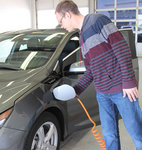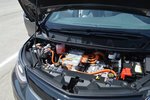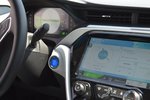



It’s an understatement to say DJ Hardesty loves cars. He doesn’t just love to drive them, he has a knack for talking about them, learning every detail and matching the right car to a new owner.
The Beaver Crossing native and 2010 Centennial High School grad is a sales consultant at a Chevrolet dealership in north Lincoln. Though he sells fuel-powered vehicles and can acquaint himself with almost any make and model, his true passion lies in electric cars.
“It’s an obsession,” Hardesty said.
He grew up loving computers and video games, so when car companies began melding high-tech computer systems with automobiles, he was hooked.
“I love cars. I love technology. It’s two of my favorite things coming together. This is basically a computer on wheels,” he said, motioning to the 2017 Chevy Volt hybrid he leased at the beginning of May.
Hardesty moved to Portland, Oregon, in 2015 to take a job with Clean Air Lawn Care, a company that operates with all-electric mowers and trimmers.
He lived about a mile from Tesla, the first auto company to produce all-electric models, and decided to apply there, landing a position as a service assistant.
“They want people not just to work on cars, but people who are passionate about that technology,” Hardesty said.
Tesla operates differently from most auto dealerships in that it doesn’t have a lot full of cars waiting to be sold. Instead, drivers custom order their cars online and have them delivered.
Hardesty’s job was to make a customer’s first experience with a new car as perfect as possible.
“I’d take it off the truck and clean it up meticulously,” he said.
He would welcome the new owner with a handshake and congratulations and then turn them over to an owner adviser to finish out the sale process.
During his time at Tesla, the company was developing its auto pilot technology, a driver-assistance feature that uses ultrasonic sensors and cameras to keep the car in its lane, assist with speed control and help with merging.
“It was brand new at the time,” Hardesty said.
Now, Tesla has fully autonomous vehicles in beta testing.
Hardesty worked at Tesla for about six months before moving back to Nebraska.
He began exploring sales opportunities to supercharge his love for electric cars. He revisited his current dealership, where he worked as a lot attendant in 2012, and was hired as a sales consultant in February 2016.
He said he could have looked at other companies, but he wanted to focus on Chevy.
“I was always attracted to the Chevy Volt,” he said.
The first-generation Volt rolled out in 2011 as a partially electric vehicle.
“They built all the technology and the engine, and then they built the car around it,” Hardesty said.
Now, Chevy has just released its all-electric Bolt EV.
Hardesty can rattle off the specs on the Volt, Bolt and Tesla cars he’s worked with, and he devotes much of his time to learning as much as he can through research and watching videos online—partly because it makes his job easier, and partly because it’s what he loves to do.
“I want to be the pinnacle of electric cars in Lincoln. I want people to say, ‘I bought mine from DJ.’ You have to know your product,” he said.
Along with knowing the product comes treating the customer with respect and patience. Hardesty said people don’t come to the dealership with the expectation to buy an electric car the same day. They come to learn.
“The whole point of car sales is taking care of the customer. It’s all about information,” Hardesty said.
One of his customers came back six times before sealing the deal—to test drive, to choose an interior, pick an exterior and otherwise customize his car.
Moving electric vehicles in a region that buys heavily into the truck market is a challenge, and for Hardesty, that means breaking the stereotype of what an electric vehicle can do by educating people about the technology.
“People are too scared, that’s what I’m learning. Breaking down those barriers is going to help tenfold,” Hardesty said.
When it first came out, the Volt was only available for purchase in seven states. Hardesty said it took time to convince the manufacturer to send them to Nebraska.
“It’s really, really tough to get them here. GM has to allocate them,” he said, and the company only allocates cars where they sell best.
“It’s why we have so many trucks and very little hybrids, which would be opposite of a Chevrolet dealer in a metropolitan area,” Hardesty said.
Once he could prove his ability to sell the Volt to a customer without that customer actually seeing the vehicle, the company began granting more orders.
“That’s how it started, and now I have three here,” he said.
Hardesty has sold seven Volts in the last year and a half. At the start of May, he leased a heather grey 2017 Volt to drive himself.
The car has four drive modes that utilize either its 18.4-kilowatt-hour lithium ion battery, its nine-gallon gas tank or both.
On a full charge and a full tank, the car can travel up to 420 miles at 60 mph.
If the battery doesn’t run for 42 days straight, the engine automatically kicks on for a maintenance cycle. After 365 days of not using the gas component, a specially designed gas cap burns off the remaining fuel to keep it from going stale.
The car also features regenerative braking, which allows the driver to slow down without pressing the brake pedal.
A paddle on the steering column can control braking, and the excess forward motion energy is returned to the battery instead of lost. This cuts down on emissions and brake maintenance costs.
With an instant torque engine, the car takes only a couple of seconds to go from 0 to 60 mph.
“If you need to overtake somebody, it’s really beneficial,” Hardesty said.
The speed and dynamics of the car weren’t the main draw for him. He chose the car because of its efficiency.
The battery can be charged at home or at public charging stations in most cities.
Charging takes anywhere from 5 to 14 hours depending on the hookup and rate of electrical flow. Some public charging stations have a $1 to $2 session fee, but many are free to use.
Hardesty said opponents of electric vehicles are quick to point out that mining the minerals needed for a lithium ion battery is hard on the environment, but the batteries are 100 percent recyclable, which means as the cars age, the batteries can be revamped and reused without mining new material.
“They’re not just letting these go. It’s a very valuable resource,” he said.
In April, Hardesty was chosen as one of four employees from his dealership to attend the Chevrolet New Roads event, a demonstration of Chevy’s 2018 lineup in Fort Worth, Texas.
They took a class to learn about new cars, accessories and trim packages. Then, they had the chance to drive the not-yet-released Colorado ZR2, Equinox, Silverado 2500HD and Camaro ZL1 models on an agility course.
The highlight for Hardesty was getting to open up the new Corvette Grand Sport on the Texas Motor Speedway at more than 100 mph, and of course, taking a spin in the new Bolt EV.
“It felt really cool. I could come back knowing how it feels to drive one and that this company sent me down there to drive all this extra stuff,” he said.
Though he works for Chevy, Hardesty still gets excited about Tesla’s innovations, including the Tesla Model 3, which will begin production later this year as the most advanced electric vehicle on the market.
He doesn’t just push electric cars to make a sale. He strongly believes in the technology and the difference electric engines are making in the world.
“I see it being the future,” he said. “I see driving a gas car will be a novelty.”